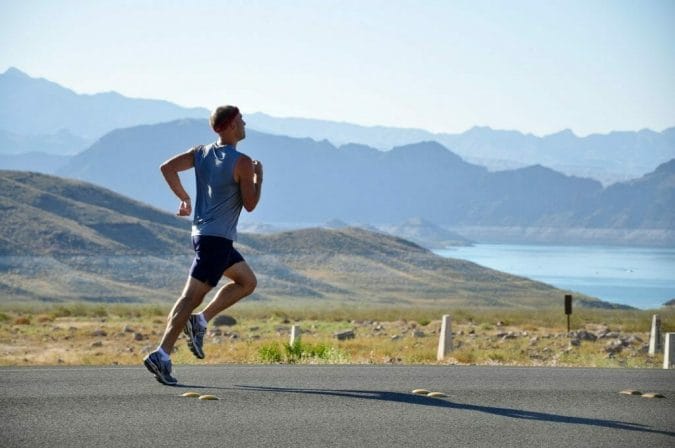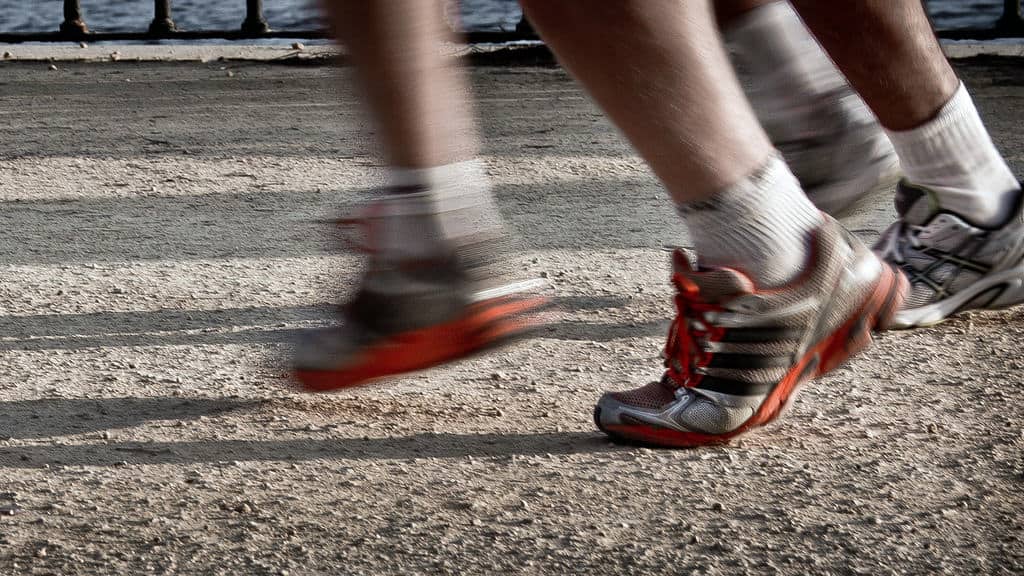Running is becoming more and more popular year after year among people with a healthy, active lifestyle. Why do we reach for jogging most often? It is a reliable way to slim down the figure quickly and get rid of fat ballast, as well as a comprehensive health support. In fact, there are many more benefits of running. This unique type of sport also reflects positively on our emotions, mood, working mind, personality and even interpersonal relations. However, to enjoy all the benefits of running, we need to do it systematically, which many people unfortunately fail to do. A significant number of people who start running quickly demotivate and abandon the sport. Find out how to start running, how to avoid discouragement with running and why running is actually worth it. And get infected with jogging!
Table of contents
- 1 Running – the easiest way to horse health and reliable mental and physical fitness
- 2 The effects of running after two weeks of regular training.
- 3 Effects of running after a month
- 4 What are the effects of running? Why is it worth running?
- 4.1 Running is the most effective way to intensively accelerate weight loss
- 4.2 Running is an effective way to a slim, athletic figure
- 4.3 Running has a positive effect on the functioning of the entire body
- 4.4 Running strengthens bones and joints
- 4.5 Running strengthens the body’s immunity
- 4.6 Running strengthens the heart and protects the cardiovascular system
- 4.7 Running has an extremely beneficial effect on brain function
- 4.8 Thanks to running, we have a better mental and physical well-being
- 4.9 Running improves mental fitness and develops personality
- 5 How to start running and what mistakes to avoid?
Running – the easiest way to horse health and reliable mental and physical fitness

Running is a hugely popular discipline that captivates more and more amateurs of physical activity. Running is simple, enjoyable and economical (no cost, no need for any exercise equipment or devices). It is also versatile and affordable – you can run at any age, anywhere and in almost any weather conditions (except rain, snow, frost, although even these are not an obstacle for some).
Most importantly, running is extremely effective in improving health, reducing the risk of disease and improving your figure. It also gives very fast results. After just a few workouts, you can see progress in both fat burning and form improvement.
The effects of running after two weeks of regular training.
We will notice the visible effects of running already in the second week of regular training. We will notice a jump in physical form, exercise capacity and overall fitness will improve. We will be able to run for about 15 minutes in one go, we will tire more slowly, we will catch breathlessness less often, our muscles will be able to do more work without the effect of exhaustion.
Our blood circulation will improve and our breathing will deepen, so the whole body will begin to be better oxygenated. We will have more energy during the day and sleep better at night. Our skin will look more crisp and vital. The silhouette will begin to change from sluggish, to dynamic, slender. The muscles of the legs, buttocks, abdomen will work better and get stronger. We will begin to get rid of excess subcutaneous water, metabolism will accelerate, we will begin to consume the calories consumed faster, which in the following weeks will bring us the effect of reducing unwanted pounds.
Effects of running after a month
After a month of running training performed systematically, several times a week, the changes in the appearance of the figure and the functioning of the body will already be evident. The amount of fat in all areas of the body will decrease, the figure will be slimmer, the posture will be more upright, and the muscles will be better outlined. The buttocks will begin to become rounder and firmer, the legs will become stronger. You will also notice a change in the appearance of calves and thighs – they will become more slender and shapely. The body will also begin to burn unnecessary fat effectively.
What’s more, after a month of running, your skin will become smoother and tighter, gain a healthier, nicer tone and look younger. Cellulite will also be reduced (running excellently stimulates blood and lymph circulation, so subcutaneous water, toxins and fat deposits forming cellulite are broken down and removed much more effectively and quickly).
Regular running training for about a month will also bring with it a number of health benefits: The body will be much better oxygenated and nourished, the heart muscle will work more efficiently and in a more normalized way, and the condition of veins and arteries will improve.
The effects seen after a month of running also include a much faster metabolism, better digestion and more normalized carbohydrate metabolism(more stable blood sugar levels). After a few weeks of running, headaches will also be alleviated (if you suffer from them), the quality of your sleep will improve, you will gain better immunity and be less susceptible to stress and fatigue. In the following weeks, all these positive changes will deepen.
What are the effects of running? Why is it worth running?

Running is a way to de-stress, relax, improve your shape and figure. It is also a natural panacea for many ailments. It is an extraordinary sport that many people believe even has healing properties. Thanks to running, blood pressure and blood glucose and cholesterol levels are stabilized, the endocrine system works better and the musculoskeletal system works more efficiently, and these are just a few of the health benefits of running. Running also helps with recovery in many of life’s situations. There are numerous cases where, thanks to running, chronically ill people, people with disabilities and those who have undergone serious injuries and other health turbulence have clearly gained in health, come to a good disposition and improved the condition of their bodies.
According to numerous studies, runners live longer. Other studies show that runners have a much lower risk of atherosclerosis and other cardiovascular diseases. Why is it worth running? Here are the most important health benefits of running:
Running is the most effective way to intensively accelerate weight loss
Express fat burning is one of the most important advantages of jogging. The amount of energy used by the body during a single running workout and the rate of lipolysis (the process of breaking down fat) in people who jog periodically is so high that regular jogging can be called the most effective natural weight loss remedy. By running about 4 times a week for min. 30 minutes we will notice rapid weight loss, even more so if we combine jogging with a diet in which the amount of calories consumed will be about 300 kcal less than our daily caloric requirements.
During running, all parts of the muscles are activated to work, so our body uses very large amounts of energy. Hence such intense calorie burning – even 600-700 kcal in an hour. The effects of running uphill (in the field or on an exercise treadmill with an increased angle of inclination) are even more spectacular: in 60 minutes we can burn up to 900 kcal.
Due to the huge muscle involvement and high energy expenditure, the body of a running person not only burns calories supplied on a regular basis in food, it must also mobilize fat reserves. Lipids stored in adipocytes (fat cells) are broken down into free fatty acids, after which they are released into the bloodstream, then consumed by tissues as fuel. As a result of this process, adipocytes shrink and fat tissue is gradually lost. The rate of weight loss with a training plan that includes several sessions per week is therefore very high – you can lose about 5 kg in a month (and with a change in diet even more!).
Check: Fat Burners Ranking
Running is an effective way to a slim, athletic figure
The benefits of running for our figure are not only the reduction of excess pounds, but also the overall slimming and firming of the body and improvement of muscles. Running is an effective way to sculpt your figure, especially if you combine this discipline with strength training.
During regular running, fat gradually disappears from the entire body, and in parallel the level of muscle tissue increases. The muscles of the buttocks, abdomen, thighs, calves, shoulders, back are strengthened and emphasized, adding an athletic touch to our silhouette. Jogging is also a patent for improving coordination and shaping motor skills such as speed, agility, endurance and strength.
Read also: Workout For Reduction
Running has a positive effect on the functioning of the entire body

Running has a positive effect on many functions of our body. When we run, our lungs become stronger, their capacity increases, and our pulse rate accelerates. We breathe in more air, blood circulates through our body faster, and thus more oxygen and nutrients reach cells and tissues throughout the body, biochemical processes run more efficiently, systems and organs work better. Better oxygenation also means better sleep and more efficient nighttime recovery.
As a result of increased blood flow through the body, metabolic processes also run better, and toxins and harmful products of metabolism are removed from the body faster.
Running strengthens bones and joints
Improved gas exchange mechanism results in better nutrition and mineralization of bones and joint structures. It translates into their strengthening, increased density and mass, and more efficient regeneration. Also, the fact that joints and bones undergo regular activation during running makes them stronger and more resistant to damage.
Running strengthens the body’s immunity
Regular, moderate, not too intensive running training contributes to improving the body’s immune response when it comes into contact with pathogens. By promoting the systematic strengthening of the body and building natural immunity, running training leads to a reduced susceptibility to colds, infections, allergies. If viruses, bacteria or other pathogens enter the body, they are more quickly caught and neutralized, resulting in a shorter period of illness and a lighter course.
Running strengthens the heart and protects the cardiovascular system
It is not without reason that moderate running is recommended for those noting the first symptoms of cardiovascular and heart problems, such as elevated blood pressurearterial pressure, arrhythmia, leg varicose veins, heaviness and swelling of the legs, vascular spider veins or abnormal levels of cholesterol and triglycerides in the blood. There is no doubt that running is one of the more effective non-pharmacological ways to regulate cardiovascular function.
When we run, blood circulates faster and the heart muscle works harder to pump it efficiently. Over time, in a beneficial way, the heart remodels and grows (the heart cavities enlarge, the left ventricle becomes thicker). It becomes stronger, sturdier and more resistant to any exertion. The runner’s heart is also more capacious. In a given unit of time, several times more blood flows through it than through the heart of a physically inactive person.
Increased blood flow and the formation of a larger network of small blood vessels in regular runners results in better access of cells, tissues and organs to nutrients (they are transported with the blood). The result is more efficient functioning of organs, muscles, glands and better skin condition. As a result of running, the work of the heart is normalized, it is calmer, its rhythm is more steady. Blood pressure returns to balance. The condition of blood vessels also improves – they become more flexible, less permeable, stronger.
Regular jogging is also a valuable help for those struggling with varicose veins. This is because running excellently stimulates circulation in the lower limbs, so that the veins function better and the blood circulates more dynamicallyveins and stops backing up and lingering in the legs, causing pressure, pain and swelling. Running also reduces the risk of cardiovascular diseases such as hypertension, coronary artery disease, atherosclerosis and heart attack. Running lowers the level of bad cholesterol in the blood and prevents blood clots in blood vessels.
Running has an extremely beneficial effect on brain function
The positive effects of running will also be felt by our sensitive organ, the brain. Thanks to jogging, it is better supplied with blood and oxygen, so it can work more efficiently. It translates into improved cognitive processes, including better memory (we remember, assimilate and reproduce information better), deeper and longer-lasting concentration on a given task, faster and more creative thinking. With running, our analytical abilities are also improved, we can work at high mental speed longer and more efficiently, and the effect of mental fatigue occurs less often and is less intense.
Thanks to running, we have a better mental and physical well-being
Running is an antidote to all sorts of minor ailments that each of us faces on a daily basis. Systematic jogging great hardens the body, restores homeostasis in it, regulates the process of hormone secretion. Runners complain much less often about complaints of pain, migraines, insomnia. They get sick less often, stay young and fit longer and live longer. Listing the benefits of running, we can’t help but also mention that it lowers the risk of cancer, Alzheimera disease, diabetes, osteoporosis and depression.
Running improves mental fitness and develops personality

The positive effects of running on the psyche cannot be forgotten either. The running effort causes our body to increase the secretion of neurotransmitters such as dopamine, endorphin, serotonin. These are customarily referred to as happiness hormones, as they are responsible for mood elevation and positive emotions such as joy, contentment, enthusiasm for action. Running is also an effective way to combat neurosis and depressive disorders.
By practicing jogging, we also shape our character, become mentally stronger, distanced from problems, more resistant to stress. We are able to get rid of negative thoughts more easily, we are less often hit by despondency and sadness, grief, discouragement, resignation. Instead, our self-confidence increases, we become more strongly motivated to make positive changes in life and, above all – happier.
Check: Stress Pills Without Prescription – Ranking.
How to start running and what mistakes to avoid?
Running can have a very positive impact on our health, life and figure, but before we start running, it’s worth learning some valuable tips.
Excessive training at the beginning of our running adventure can leave us overstressed, overtired and discouraged from training. They can also end up in injuries or joint strain. We should remember that any physical activity, including running, requires getting into it gradually. Meanwhile, many people decide to go for long, dynamic runs at the very beginning, which, unfortunately, often ends in one big breathlessness, exhaustion and a quick departure from the sport.
How to start running? Here’s what to remember:
- Enter into running activity gradually, choose the time of running according to your own abilities. In the beginning, instead of running for a long time in one go, marchers will work well. Gradually increase the distance and intensity of your runs. During the first training, bet on dynamic marching with short phases of jogging. During subsequent workouts, lengthen the running phases and shorten the marching phases. Over time, you will be able to run about 15 minutes in one go. The next step will be 20 minutes, then half an hour of continuous running, and so on.
- Leave daily running for later phases of running advancement. To begin with, it’s enough to run about 3 times a week. Only after you get your muscles and joints used to running activity can you decide to increase the frequency of training to 4-6 per week. Even at a high level of training, however, it is worth taking at least a day off for recovery.
- If you want running to bring you rapid weight loss, take care of a proper diet as well. The best results come from a healthy diet, based on natural products and at the same time well-balanced (containing all nutrients in the right proportions) with slightly reduced calories (about 200-300 kcal).
Read also: diet for reduction
- Remember to have adequate fluid intake. Water is of course the basis, but you don’t have to drink only it. Also reach for fruit and vegetable juices, isotonic drinks, green tea, water diluted with fruit juice, etc. Before and after training, drink min. 300-400 ml of water. In addition, sip water in small portions throughout the day. To avoid dehydration, drink about 2.5 liters of water a day (plus other fluids).
- Equip yourself with special running shoes that provide adequate cushioning, stability and protection for your joints. Don’t run in casual trainers or sneakers.
- Use a warm-up before running, and a deconditioner after running, stretching. Take care of post-workout recovery (adequate quantity and quality of sleep, rest). And most importantly – do not overtrain, do not train too intensively. This way you will avoid injuries, joint and tendon strains and a decline in form.

